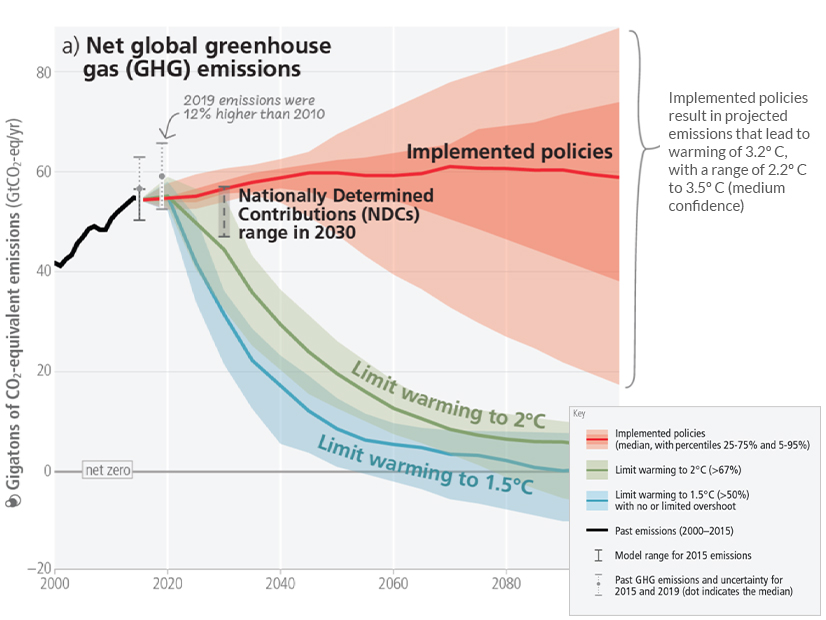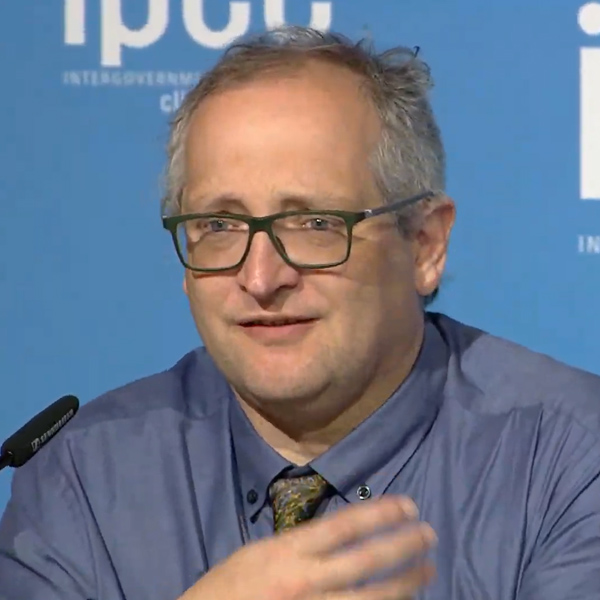
If the world does not slash its greenhouse gas emissions immediately, it will likely hit the 1.5-degree Celsius tipping point for potential climate catastrophe by the mid-2030s, according to one of the lead authors of the Sixth Assessment Report (AR6) Synthesis released Monday by the U.N.’s Intergovernmental Panel on Climate Change (IPCC).
“The real question is whether our will to reduce emissions quickly means we reach 1.5 degrees [and we] go a little bit over but then come back down, or whether we go blasting through 1.5 degrees, go through even 2 degrees and keep on going,” Peter Thorne said at a press conference livestreamed from Interlaken, Switzerland. “This is why the rest of this decade is key. The rest of this decade is whether we apply the brakes and stop the warming.”
The 1.5-degree limit for climate change was originally set by the Paris Agreement, finalized at the 2015 U.N. Climate Conference of the Parties (COP21), and kept alive, barely, at subsequent U.N. conferences, including COP27 in Egypt last November. The AR6 Synthesis, a combination of three previous IPCC reports, once again raises an urgent and immediate call to nations to up their commitments and their actions to make deep cuts in GHG emissions by 2030. (See Closing the Emissions and Honesty Gaps at COP27.)
 UN Secretary General António Guterres | IPCC
UN Secretary General António Guterres | IPCC
In a video message to the Interlaken event, U.N. Secretary General António Guterres called the report “a how-to guide to defuse the climate time bomb,” as well as “a survival guide for humanity.” He then proposed an “acceleration agenda,” with the Group of 20 (G20) countries with the largest economies, including the U.S., to committing to net-zero electricity generation by 2035 and net-zero economies by 2040.
Targets for developing countries would be 2040 for net-zero electricity and 2050 for net zero economy-wide.
The plan also calls for phasing out coal by 2030 in developed countries and 2040 in all other countries, and “a global phasedown of existing oil and gas production compatible with the 2050 global net-zero target,” Guterres said.
“I am also calling on CEOs of all oil and gas companies to be part of the solution,” he said. “They should present credible, comprehensive and detailed transition plans … [with] actual emission cuts for 2025 and 2030 and efforts to change business models to phase out fossil fuels and scale up renewable energy.”
Developed countries must also deliver on their financial commitments to help developing countries with their own energy transitions and create “a roadmap to double adaptation finance before 2025.” The new loss and damage fund agreed to at COP27, to compensate developing countries already suffering from the effects of climate change, should be implemented this year, Guterres said.
“In short, our world needs climate action on all fronts: everything, everywhere, all at once,” Guterres said.
The Synthesis report also sets a marker for COP28, to be held in the United Arab Emirates in November, when the first “global stocktake” will be held to evaluate nations’ progress toward the goals of the Paris Agreement. The stocktake is a two-year process, which began at in 2021, at COP26 in Glasgow, according to the U.N.
“The global stocktake is critically important because the international community has yet to live up to its commitments, and climate action has yet to reflect deep transformations needed across all sectors to build a resilient future,” the U.N. said in a blog post.
‘The Ultimate No-brainer’
With each successive IPCC report, the evidence of warming and its impacts grow more alarming and potentially catastrophic. Figures in the AR6 Synthesis show that global surface temperatures were already close to 1.1 degrees higher in 2011-2020 than in the last half of the 19th century.
“In 2019, atmospheric CO2 concentrations (410 parts per million) were higher than at any time in at least 2 million years,” the report says. “Concentrations of methane (1,866 parts per billion) and nitrous oxide (332 parts per billion) were higher than at any time in at least 800,000 years.”
The impacts include higher mortality rates from extreme weather events, food and water insecurity, and “hundreds of local losses of species,” the report says. “Approximately 3.3 billion to 3.6 billion people live in contexts that are highly vulnerable to climate change,” with “the largest adverse impacts” being felt in developing countries and among remote populations in island nations and indigenous communities.
As an immediate step, Guterres called for global early warning systems against natural disasters within four years. But the report also suggests that as global temperatures continue to rise, causing more frequent and severe extreme weather events, such systems and other adaptation measures could rapidly lose their effectiveness.
Adaptation is widely defined in the report to include agricultural practices such as soil conservation, as well as wetlands and forests restoration and green urban planning. But “unless mitigation [to cut emissions] also happens at the pace that’s required, many of the adaptation [measures] we’re investing in now will not remain as effective as they are today,” said Aditi Mukherji, another lead author.
Still, IPCC Chair Hoesung Lee said the report also provides a message of hope that “we already have the technology and know-how to get the job done.” His list of immediate to-dos includes “renewable energy instead of fossil fuels, energy efficiency, green transport, green urban infrastructure, halting deforestation, ecosystem restoration, and sustainable food systems that reduce food loss and waste.”
“Investing in these areas and more besides will help to stabilize our climate change, nature and biodiversity loss, and pollution and waste,” he said. “It is frankly the ultimate no-brainer.”
Looking at currently available technologies, Lee pointed to energy efficiency as an area ripe for expansion, with the potential to cut energy demand by 40 to 70% in some sectors over the next two decades. Urban centers could also achieve major reductions in emissions through “comprehensive, climate-friendly development patterns,” he said.
Finance will be another vital area for climate action, said Dipak Dasgupta, another lead author. “At the core, [the] financial system needs to respond to the challenges ahead. … Our underlying assessment suggests that … the investments that need to take place in climate adaptation and mitigation need to rise by two to six times at least.”
The way forward must combine government policy with a shift in financial institutions, Dasgupta said. “The central banks, the regulators themselves, have to start recognizing the urgency,” he said. Finance needs to flow to the least developed, most vulnerable areas that need it the most, sooner rather than later, he said.
The authors also argued for more than institutional change. “What we need now is a political will on the part of the policymakers [and the] constituents [who decide] who would be the political leaders,” Lee said.
 Peter Thorne, a lead author of AR6 Synthesis | IPCC
Peter Thorne, a lead author of AR6 Synthesis | IPCC
Public support for immediate action is critical, with individual, “personal motivation” driving a policy path toward net zero, he said.
Thorne agreed that a level of personal commitment is going to be needed to push past “the point … where climate change can be somebody else’s problem. If we had had to the foresight to act in 1990, to start to act in a meaningful way … we would have a vast array of options available to us to still avoid 1.5,” he said.
“We have to act now … across all scales. Do not say it is your government’s problem, your community’s problem. It is your problem as part of that community, as part of that country, to make a difference at this point for a resilient future.”
Climate Tradeoffs
President Biden has already committed the U.S. to cutting GHG emissions by 50 to 52% by 2030, decarbonizing the electric power system by 2035 and going net zero economy-wide by 2050. But, according to the AR6 Synthesis, even such ambitious targets may not be enough to curb climate change.
“Only a small number of the most ambitious global modeled pathways to limit global warming to 1.5 degrees C … by 2100 [do so] without exceeding this level temporarily,” the report says. One way forward is having “annual rates of [carbon dioxide removal] greater than residual CO2 emissions.”
Jessie Stolark, executive director of the Carbon Capture Coalition, welcomed the report’s support for carbon-removal technologies and “the critical role that dramatically accelerated deployment of carbon-management technologies and associated infrastructure must play in managing emissions.”
Pointing to new incentives for carbon capture and sequestration in the Inflation Reduction Act, Stolark said, “The task ahead requires us to heed the continued and increasing alarms being sounded by the world’s scientific community and implement the available policy framework in a swift and effective manner, to ensure carbon-management technologies can achieve their full greenhouse gas emissions reductions potential, as outlined in this new report.”
Recent reports from the U.S. Energy Information Administration and the National Renewable Energy Laboratory also underline the pivotal role computer models may play in determining whether the political, personal and financial will can be mustered for effective and sustained climate action.
The EIA’s Annual Energy Outlook (AEO) 2023 predicts the U.S. will be able to cut its CO2 emissions by 25 to 38% below 2005 levels by 2030, falling well short of Biden’s target. The AEO sees electric generating capacity doubling by 2050, with solar, wind and storage accounting for most of the increase, but nuclear and natural gas remain more or less static. (See EIA: Major Solar Growth Ahead, but EV Adoption Stalls After 2030.)
The range for solar runs from 22 to 56% of U.S. power production, EIA Assistant Administrator Angelina LaRose said at a launch event for the report in D.C. on Thursday. Bonus tax credits in the IRA — for example, for projects paying prevailing wages and offering registered apprenticeships — could raise those figures to 39 to 59%, LaRose said.
But, the AEO’s estimates in many cases did not take into account the full potential impact of IRA incentives, according to EIA Administrator Joseph DeCarolis, because the Internal Revenue Service has yet to issue final guidance on how they will be implemented.
The NREL report, also released on Thursday, used a different computer model, which did factor in a fuller picture of the IRA. Combined with provisions of the Infrastructure Investment and Jobs Act, the IRA incentives could drive clean energy to 71 to 90% of all power generation, while also cutting power sector CO2 emissions by 72 to 91% below 2005 levels, both by 2030, the report says.
Supporting those figures will also require “over 24 TW-miles [terawatt-miles] of new long-distance transmission” to be deployed by 2030, “a 16% increase in total installed capacity compared to today,” the report says. Without it, wind power deployments could fall from providing 29% of U.S. electric generation to 22%, the report says.
Steven Rose, principal research economist at the Electric Power Research Institute, cautioned about the need to understand the assumptions built into different models, whatever the climate goals being advanced.
“There are typically fairly strong policy and technology assumptions behind those [goals],” Rose said in an interview with NetZero Insider. “Getting down to specifics of policies, as opposed to more stylized conditions that models tend to represent, one of the things I would highlight is that local opportunities [for climate action] are going to vary significantly. If we think about people in this country, we think about different parts of the country and what might be their opportunities for decarbonizing. … There’s no one-size-fits-all. …
“There are clearly options for mitigating climate change, but they’re not all equal,” said Rose, a review editor of the AR6 Synthesis and a lead writer on a previous IPCC report. “So, we need to think about how we’re going to try to facilitate and achieve decarbonization, recognizing that there are some tradeoffs that need to be recognized and considered … and balanced.”
